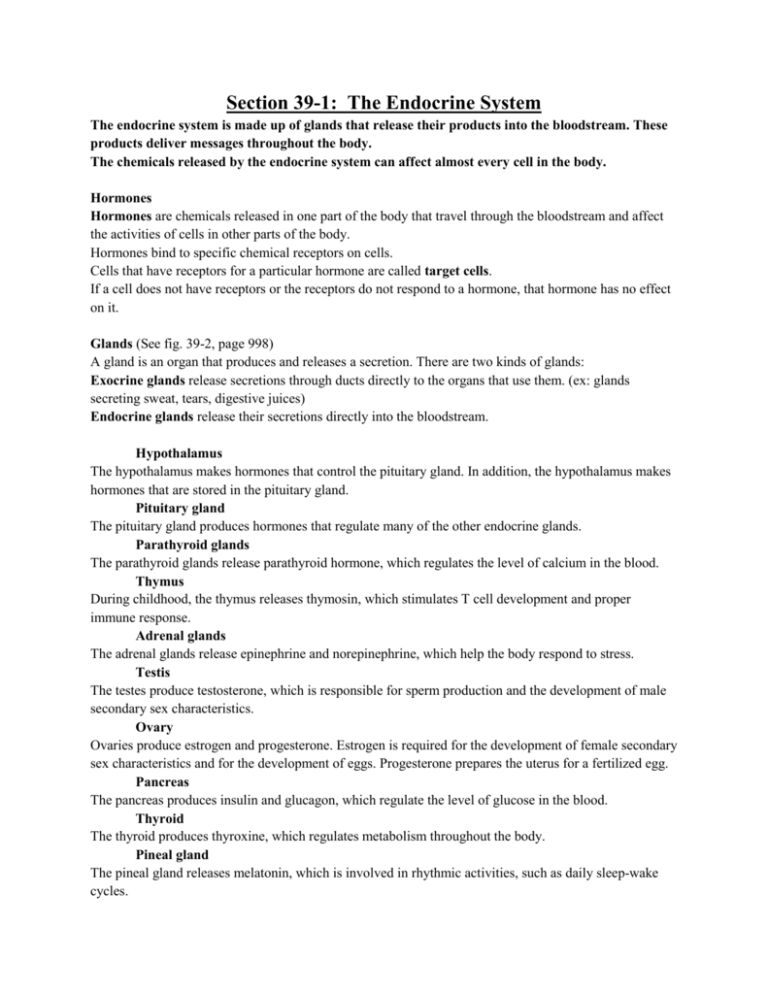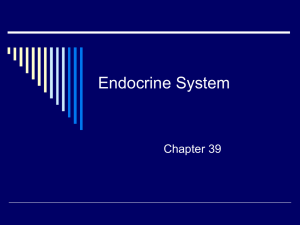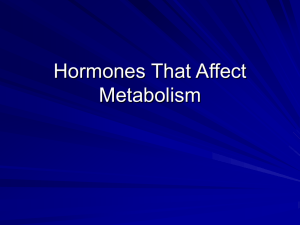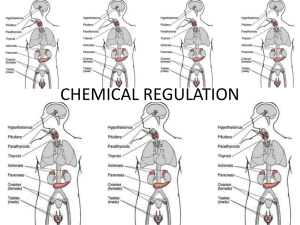File
advertisement

Section 39-1: The Endocrine System The endocrine system is made up of glands that release their products into the bloodstream. These products deliver messages throughout the body. The chemicals released by the endocrine system can affect almost every cell in the body. Hormones Hormones are chemicals released in one part of the body that travel through the bloodstream and affect the activities of cells in other parts of the body. Hormones bind to specific chemical receptors on cells. Cells that have receptors for a particular hormone are called target cells. If a cell does not have receptors or the receptors do not respond to a hormone, that hormone has no effect on it. Glands (See fig. 39-2, page 998) A gland is an organ that produces and releases a secretion. There are two kinds of glands: Exocrine glands release secretions through ducts directly to the organs that use them. (ex: glands secreting sweat, tears, digestive juices) Endocrine glands release their secretions directly into the bloodstream. Hypothalamus The hypothalamus makes hormones that control the pituitary gland. In addition, the hypothalamus makes hormones that are stored in the pituitary gland. Pituitary gland The pituitary gland produces hormones that regulate many of the other endocrine glands. Parathyroid glands The parathyroid glands release parathyroid hormone, which regulates the level of calcium in the blood. Thymus During childhood, the thymus releases thymosin, which stimulates T cell development and proper immune response. Adrenal glands The adrenal glands release epinephrine and norepinephrine, which help the body respond to stress. Testis The testes produce testosterone, which is responsible for sperm production and the development of male secondary sex characteristics. Ovary Ovaries produce estrogen and progesterone. Estrogen is required for the development of female secondary sex characteristics and for the development of eggs. Progesterone prepares the uterus for a fertilized egg. Pancreas The pancreas produces insulin and glucagon, which regulate the level of glucose in the blood. Thyroid The thyroid produces thyroxine, which regulates metabolism throughout the body. Pineal gland The pineal gland releases melatonin, which is involved in rhythmic activities, such as daily sleep-wake cycles. Hormone Action (See fig. 39-3, page 999) Hormones are classified as either steroids or nonsteroids. Steroid hormones are produced from a lipid called cholesterol. Nonsteroid hormones include proteins, small peptides, and modified amino acids. Steroid Hormones Steroid hormones can cross cell membranes easily. A steroid hormone enters a cell directly across its membrane and binds to a receptor to form a hormonereceptor complex. The hormone-receptor complex enters the nucleus, where it binds to a DNA control sequence. Binding initiates transcription of genes to mRNA, which moves into the cytoplasm to direct protein synthesis. Hormone-receptor complexes regulate gene expression. Because steroid hormones affect gene expression directly, they can produce dramatic changes in cell and organism activity. Nonsteroid Hormones Nonsteroid hormones cannot pass through the cell membrane. A nonsteroid hormone binds to receptors on the cell membrane. This activates an enzyme on the inside of the membrane. This enzyme activates secondary messengers that carry the message of the hormone inside the cell. These messengers activate and inhibit many cell activities. Prostaglandins All cells (except red blood cells) produce small amounts of hormone-like substances called prostaglandins. Prostaglandins are modified fatty acids that affect nearby cells and tissues, and are known as “local hormones.” Some prostaglandins cause smooth muscles to contract. Control of the Endocrine System The endocrine system is regulated by feedback mechanisms that function to maintain homeostasis. Example: Controlling Metabolism (See fig. 39-4, page 1000) Thyroxine, a hormone of the thyroid gland, affects the activity of cells throughout the body, increasing their rate of metabolism. A drop in thyroxine decreases the metabolic activity of cells. If thyroxine is low, the hypothalamus secretes thyrotropin-releasing hormone (TRH), which stimulates the anterior pituitary to secrete thyroid-stimulating hormone (TSH). TSH stimulates the release of thyroxine. High levels of thyroxine in the blood inhibit secretion of TRH and TSH, which stops the release of additional thyroxine. The hypothalamus is also sensitive to temperature. If body temperature drops, it produces extra TRH. TSH is released, which causes the release of more thyroxine. Thyroxine increases oxygen consumption and cellular metabolism. Increased metabolic activity maintains a core temperature. Complementary Hormone Action Sometimes two hormones with opposite effects act to regulate part of the body’s internal environment. Such a complementary system regulates the level of calcium ions in the bloodstream. Two hormones that regulate calcium concentration are calcitonin and parathyroid hormone (PTH). Calcitonin decreases the level of calcium in the blood, while PTH increases it. If calcium levels are too high, the thyroid secretes calcitonin. Calcitonin signals the kidneys to reabsorb less calcium. Calcitonin also reduces the amount of calcium absorbed in the intestines and stimulates calcium deposition in the bones. If calcium levels drop too low, PTH is released by the parathyroids. PTH, with vitamin D, stimulates the intestine to absorb more calcium from food. PTH also causes the kidneys to retain calcium, and it stimulates bone cells to release calcium stored in bone tissue into the bloodstream. Section 39-2: Human Endocrine Glands The endocrine glands are scattered throughout the body. The human endocrine system regulates a variety of activities. Any improper functioning of an endocrine gland may result in a disease or a disorder. The major glands of the endocrine system include: • the pituitary gland • the hypothalamus • the thyroid gland • the parathyroid glands • the adrenal glands • the pancreas • the reproductive glands Pituitary Gland The pituitary gland secretes nine hormones that directly regulate many body functions and controls the actions of several other endocrine glands. The pituitary gland is a structure at the base of the skull. The gland is divided into two parts: the anterior pituitary and the posterior pituitary. Hypothalamus The hypothalamus is the part of the brain attached to the posterior pituitary. The hypothalamus controls the secretions of the pituitary gland. The hypothalamus is influenced by hormone levels in the blood and by sensory information. Interactions between the nervous system and the endocrine system take place at the hypothalamus. The close connection between the hypothalamus and the pituitary gland means that the nervous and endocrine systems act together to coordinate body activities. Thyroid Gland The thyroid gland is located at the base of the neck and wraps around the upper part of the trachea. The thyroid gland has the major role in regulating the body's metabolism. The thyroid produces thyroxine, which regulates the metabolic rate of cells. Thyroid Disorders Hyperthyroidism: the body produces too much thyroxine. It is characterized by elevated temperature and metabolic rate, increased blood pressure, and weight loss. Hypothyroidism: the body produces too little thyroxine. It is characterized by lower temperature and metabolic rate, lack of energy, and weight gain. Goiter: enlargement of thyroid gland. Caused by an iodine deficiency. Parathyroid Glands The four parathyroid glands are found on the back surface of the thyroid gland. Hormones from the thyroid gland and the parathyroid glands act to maintain homeostasis of calcium levels in the blood. Parathyroid glands secrete parathyroid hormone (PTH). PTH regulates calcium levels in the blood by increasing reabsorption of calcium in the kidneys and by increasing uptake of calcium from the digestive system. PTH affects other organ systems, promoting proper nerve and muscle function and bone structure. Adrenal Glands The adrenal glands are two pyramid-shaped structures that sit on top of the kidneys, one gland on each kidney. The adrenal glands release hormones that help the body prepare for and deal with stress. An adrenal gland has an outer part called the adrenal cortex and an inner part called the adrenal medulla. Adrenal Cortex The adrenal cortex produces over 24 steroid hormones. The hormone aldosterone regulates reabsorption of sodium ions and the excretion of potassium ions by the kidneys. The hormone cortisol controls the rate of metabolism of carbohydrates, fats, and proteins. Adrenal Medulla The release of hormones from the adrenal medulla prepares the body for energy-intense activities. The two hormones released by the adrenal medulla are epinephrine and norepinephrine. These hormones: • increase heart rate, blood pressure, and blood flow to the muscles. • cause air passageways to open wider, allowing for an increased intake of oxygen. • stimulate the release of extra glucose into the blood to help produce a sudden burst of energy. Pancreas The pancreas has both exocrine and endocrine functions. It is a digestive gland whose secretions break down food. It produces insulin and glucagon, which help to keep the level of glucose in the blood stable. Insulin stimulates cells in the liver and muscles to remove sugar from the blood and store it as glycogen or fat. Glucagon stimulates the liver to break down glycogen and release glucose back into the blood. Maintaining Blood Sugar Levels When glucose levels rise, the pancreas releases insulin. Insulin stimulates cells to take glucose out of the bloodstream. Glucose taken out of circulation is stored as glycogen in the liver and skeletal muscles. In fat tissue, glucose is converted to lipids. When blood glucose level drops, glucagon is released from the pancreas. Glucagon stimulates liver cells and skeletal muscles to break down glycogen and increase glucose levels. It causes fat cells to break down fats for production of carbohydrates. This makes more chemical energy available and helps raise the blood glucose level back to normal. Diabetes Mellitus When the pancreas fails to produce or properly use insulin, diabetes mellitus occurs. Reproductive Glands The gonads are the body’s reproductive glands. The gonads serve two important functions: the production of gametes, and the secretion of sex hormones. The female gonads—the ovaries—produce eggs. The male gonads—the testes—produce sperm. The gonads also produce sex hormones. The ovaries produce the female sex hormones estrogen and progesterone. Progesterone prepares the uterus for the arrival of a developing embryo. Estrogen is needed for the development of eggs and for the formation of physical characteristics of the female body. The testes produce testosterone, which is needed for normal sperm production and development of male physical characteristics.









